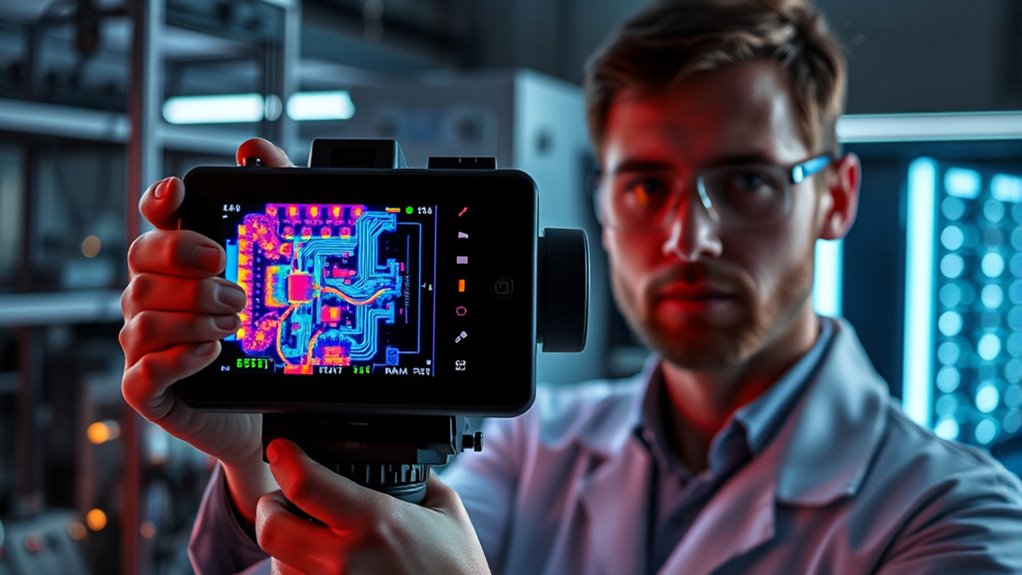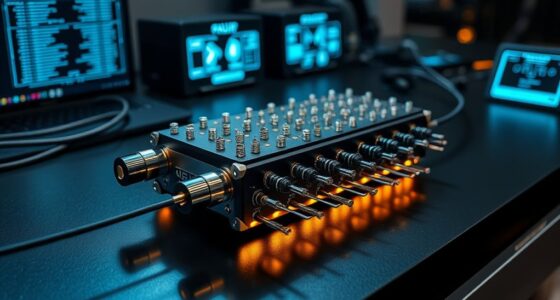If you’re searching for the top thermal imaging cameras for research in 2025, I recommend considering models with high resolution, super resolution features, and durable design. Devices like the HIKMICRO B10, F2VW, and H128 offer excellent image clarity, long battery life, and versatile modes ideal for precise thermal analysis. Each provides different features suitable for research environments. Want to see which models stand out and how to choose the right one? Keep going to find out more.
Key Takeaways
- High-resolution IR sensors with super resolution and MSX enhance image detail and accuracy for precise research analysis.
- Advanced thermal sensitivity below 40 mK ensures detection of subtle temperature variations critical for research.
- Durable, rugged designs with long battery life support extended outdoor and industrial research applications.
- Versatile visualization modes and connectivity options facilitate real-time data sharing and comprehensive thermal assessments.
- Models like H128 and F2VW offer professional-grade performance suitable for electrical, mechanical, and scientific research in 2025.
HIKMICRO B10 Thermal Camera with IR and Visual Cameras
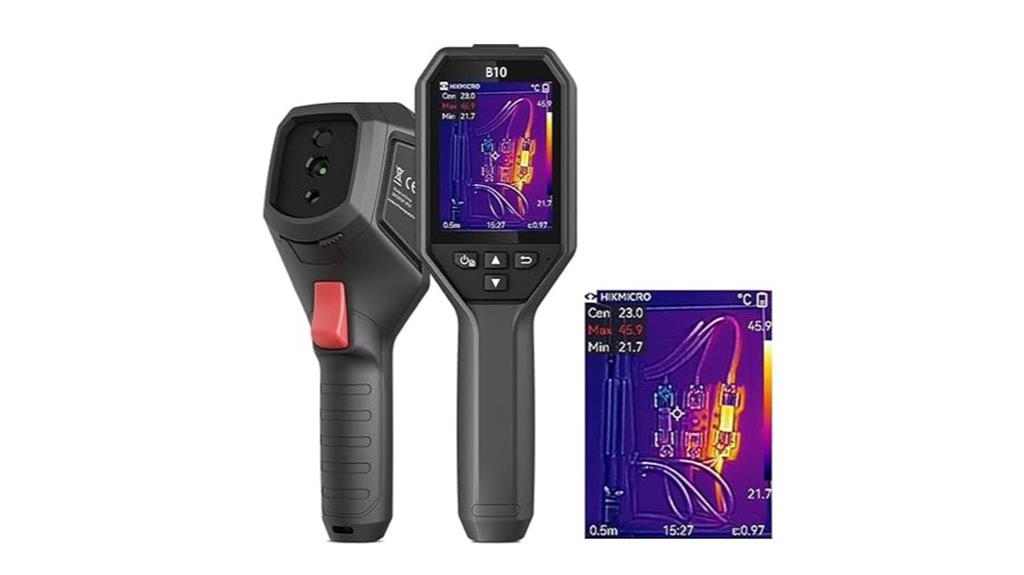
If you’re looking for a versatile thermal imaging camera suited for detailed research and troubleshooting, the HIKMICRO B10 stands out with its dual IR and visual cameras. It features a 256 x 192 IR resolution, which upscales to 320 x 240 for finer thermal details, and a 2MP visual camera for optical imaging. Fusion mode overlays thermal and visual images, enhancing clarity. With multiple modes, six color palettes, and automatic presets, it quickly helps identify anomalies. The device’s 25Hz frame rate ensures smooth imaging in dark environments, and its temperature range from -4°F to 1022°F supports various applications. It’s a powerful, user-friendly tool for precise thermal analysis.
Best For: professionals and enthusiasts seeking detailed thermal and visual inspection capabilities for electrical, mechanical, and building diagnostics.
Pros:
- High IR resolution with SuperIR upscaling for detailed thermal imaging
- Dual cameras with fusion mode for combined thermal and optical images
- Robust construction with IP54 rating, drop resistance, and long battery life
Cons:
- Menu system can be complex for new users
- Lacks built-in video recording features
- Smaller 3.2-inch display may limit viewing comfort
F2VW Thermal Camera with 256×192 IR Resolution and 2MP Visual Camera
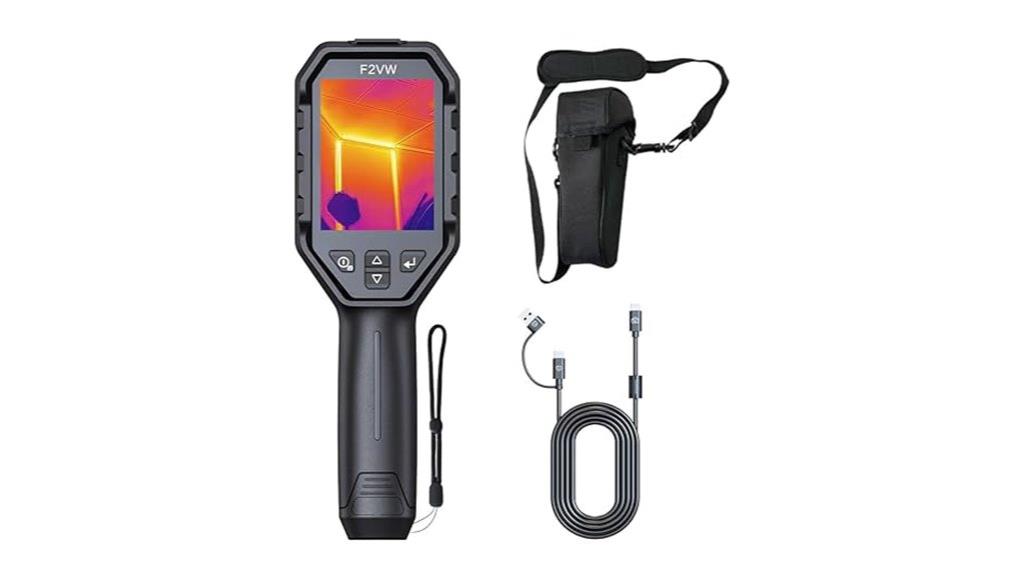
The F2VW Thermal Camera stands out as an excellent choice for researchers requiring high-resolution thermal imaging combined with visual data. It features a 256×192 IR resolution enhanced to 640×480 with Super Resolution, displayed on a 3.2-inch LCD at 25 Hz. The camera’s thermal sensitivity below 40 mK and an advanced VOx detector detect minute temperature differences with ±2% accuracy across a wide range from -4℉ to 1022℉. Its dual-camera setup offers four modes—Visual, Thermal, Fusion, and PIP—plus seven color palettes for detailed analysis. Wi-Fi connectivity and a built-in flashlight make it versatile for various research and troubleshooting applications.
Best For: Researchers and professionals needing high-resolution thermal imaging combined with visual data for detailed analysis and troubleshooting.
Pros:
- High-definition thermal images with Super Resolution boosting resolution to 640×480 for detailed visualization.
- Dual-camera setup with multiple modes (Visual, Thermal, Fusion, PIP) and color palettes enhances analysis capabilities.
- Wi-Fi connectivity and built-in flashlight increase versatility for various research environments and fieldwork.
Cons:
- Thermal sensitivity below 40 mK may be insufficient for extremely subtle temperature differences in certain specialized applications.
- The device’s complexity and feature set might require a learning curve for new users.
- Initial units experienced artifacts, which required customer service intervention for resolution.
HF96 Thermal Camera with IR Resolution

The HF96 Thermal Camera stands out for its real-time super resolution, transforming standard 96×96 IR images into detailed 240×240 visuals through live enhancement. This capability allows for clearer detection of thermal anomalies during inspections. It supports a wide temperature range from -4°F to 1022°F with ±3.6°F accuracy, suitable for various diagnostics, including home, automotive, and electrical. Features like a laser pointer, multiple color palettes, and fusion mode help focus and clarify images. Its intuitive interface, durability, and long battery life make it accessible for both beginners and professionals, delivering reliable thermal insights in diverse scenarios.
Best For: DIY enthusiasts, home inspectors, and automotive technicians seeking an affordable yet reliable thermal imaging tool for detecting heat anomalies and electrical faults.
Pros:
- Super resolution enhancement from 96×96 to 240×240 for clearer thermal images
- Long battery life of up to 11 hours supports extended inspections
- Durable IP54 rating and rugged design suitable for tough environments
Cons:
- Slow refresh rate of 25Hz may affect real-time responsiveness
- Lower IR resolution can limit detection of small hotspots
- Slightly limited advanced features compared to higher-end professional models
H128 Handheld Thermal Camera
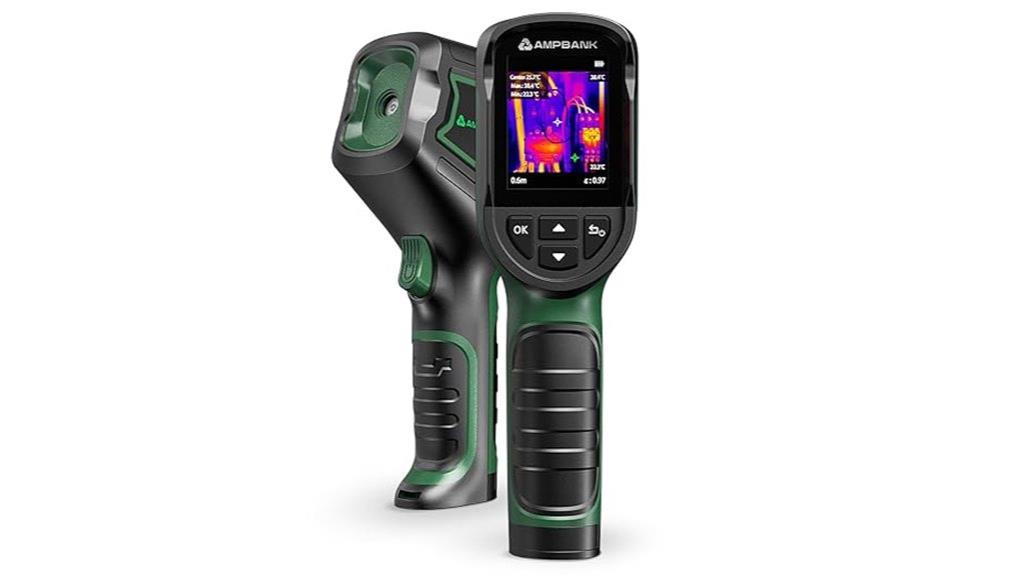
For researchers seeking a reliable handheld thermal camera, the H128 stands out with its 240×240 TISR resolution, offering considerably improved image clarity over standard 128×128 sensors. It features a thermal sensitivity of 40mk, allowing detection of tiny temperature differences, and a smooth 25Hz frame rate. With precise temperature measurements within ±3% and adjustable settings, it’s versatile for various materials. The device includes a temperature alarm for quick anomaly spotting and supports photo capture for documentation. Built to endure drops and harsh environments with an IP65 rating, the H128 is practical, user-friendly, and ideal for field inspections, troubleshooting, and professional assessments.
Best For: DIY enthusiasts, home inspectors, and professionals needing accurate thermal imaging in tough environments for troubleshooting, inspections, and documentation.
Pros:
- High 240×240 TISR resolution provides clear and detailed thermal images.
- Robust construction with IP65 rating and drop resistance ensures durability in harsh conditions.
- Long battery life of up to 24 hours supports extended fieldwork without frequent recharging.
Cons:
- Small 2-inch display can be cumbersome for detailed inspection and viewing.
- The 25Hz frame rate may cause slight lag in image refresh, affecting real-time analysis.
- Lack of an included instruction manual may require users to learn setup via quick start guides.
FLIR C5 Compact Thermal Imaging Camera

If you’re seeking a portable thermal imaging solution that delivers high-resolution images and easy data sharing, the FLIR C5 Compact Thermal Imaging Camera is an excellent choice. It features a 160×120 true thermal sensor and MSX technology, which embosses visual details onto thermal images for sharper clarity. With a 5MP visual camera, LED flashlight, and automatic temperature scales, it helps identify faults like hot fuses, air leaks, and electrical issues efficiently. Its compact size—just over 5 inches and less than 7 ounces—makes it ideal for on-the-go inspections. Seamless cloud uploads, USB transfer, and Wi-Fi support streamline documentation and sharing, enhancing workflow and accuracy.
Best For: DIY enthusiasts, home inspectors, and professionals seeking an affordable, portable thermal imaging tool for quick diagnostics and inspections.
Pros:
- Compact, lightweight design for easy portability and one-handed use.
- High-resolution 160×120 thermal sensor with MSX technology for clear, detailed images.
- Seamless data sharing via cloud, USB, and Wi-Fi, simplifying documentation and reporting.
Cons:
- Limited sensor resolution compared to higher-end models may affect image detail.
- Slow refresh rate (≤9Hz) can impact real-time responsiveness.
- Occasional overheating and durability issues after extended use reported by some users.
TOPDON TC004 Mini Handheld Thermal Imaging Camera
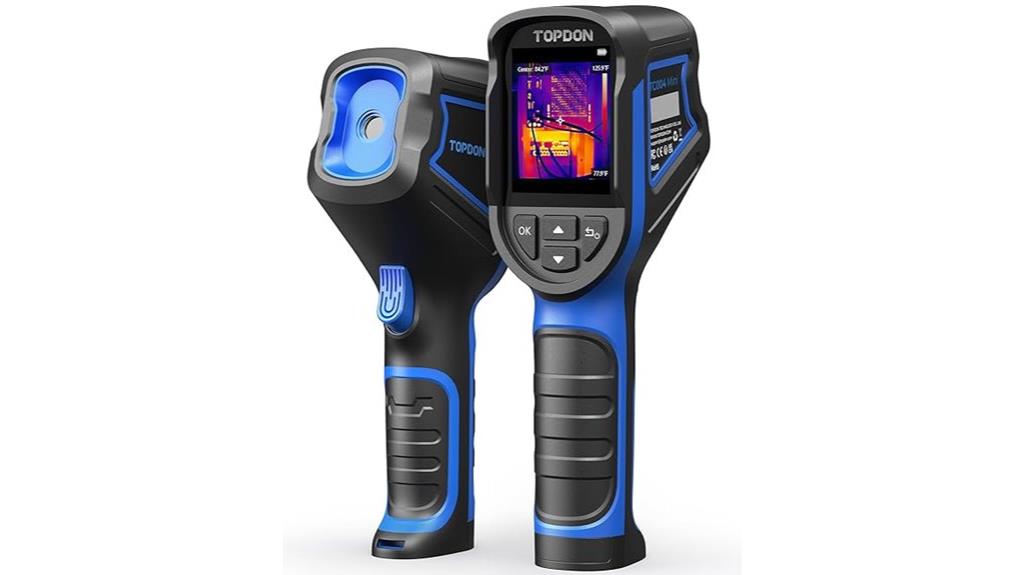
With its high-resolution 240×240 TISR thermal imaging sensor and multiple color palette options, the TOPDON TC004 Mini Handheld Thermal Imaging Camera is ideal for researchers needing detailed, accurate visuals across different environments. Its 25Hz refresh rate ensures smooth thermal images, while the five color palettes—White Hot, Black Hot, Iron, Rainbow, Red Hot—allow for tailored inspections. It measures temperatures from -4°F to 842°F and automatically highlights high, low, and central points. Compact, durable, and lightweight, it offers up to 15 hours of battery life, making it perfect for extended fieldwork. Its smart alerts and ample storage facilitate diagnostics and documentation.
Best For: researchers and professionals requiring detailed, accurate thermal imaging in various environments for inspection, diagnostics, and fieldwork.
Pros:
- High-resolution 240×240 TISR sensor provides detailed thermal images for precise analysis
- Long battery life of up to 15 hours supports extended outdoor and indoor inspections
- Multiple color palettes and automatic high/low temperature alerts enhance usability and customization
Cons:
- No included charging head; only a charging cable is provided, which may require additional purchase
- Electronic manual access requires scanning a QR code, potentially less convenient for some users
- Compact design, while portable, may have a smaller display area compared to larger models
HF96 Thermal Camera with 240×240 Resolution

The HF96 Thermal Camera with 240×240 resolution stands out as an excellent choice for researchers seeking detailed thermal data in real-time. Its super resolution transforms standard 96×96 IR images into crisp, high-detail visuals, thanks to live enhancement. Supporting a wide temperature range from -4°F to 1022°F with ±3.6°F accuracy, it’s perfect for electrical, automotive, and home diagnostics. Features like a laser pointer, multiple color palettes, and fusion mode combine thermal and optical images for precise focus. With intelligent scene recognition, manual controls, and user-friendly software, the HF96 delivers reliable, versatile performance suitable for both experienced professionals and beginners.
Best For: DIY enthusiasts, home inspectors, and automotive technicians seeking detailed, real-time thermal imaging with user-friendly features and high resolution.
Pros:
- Super resolution enhancement from 96×96 to 240×240 pixels for clearer, more detailed images
- Wide temperature range (-4°F to 1022°F) with accurate readings suitable for various applications
- User-friendly interface with integrated laser pointer and multiple color palettes for easy focus and visualization
Cons:
- Slower refresh rate (25Hz) may affect real-time dynamic scene monitoring
- Lower native IR resolution may limit detection of very small hotspots
- Limited advanced features compared to high-end professional thermal cameras
HP96 Thermal Imaging Camera with Visual Display

The HP96 Thermal Imaging Camera with Visual Display stands out for its dual-camera system, combining a thermal sensor with a high-resolution visible camera. It offers a 240×240 super-resolution thermal sensor that provides clear images during inspections. The device supports five image modes and eight color palettes, enhancing detail and contrast. Its 3.5-inch touchscreen makes operation intuitive, allowing quick mode changes and adjustments. Equipped with built-in storage, microphones, and a flashlight, it’s versatile for various environments. Its durability, lightweight design, and ability to detect subtle temperature differences make it ideal for home inspections, leak detection, and structural analysis, delivering reliable results in a compact form.
Best For: homeowners, DIY enthusiasts, and professionals seeking an affordable yet effective thermal imaging solution for home inspections, leak detection, and structural analysis.
Pros:
- High-definition 240×240 super-resolution thermal sensor for clearer images.
- User-friendly 3.5-inch touchscreen with intuitive controls and multiple modes.
- Compact, durable design with built-in storage, microphones, and flashlight for versatile use.
Cons:
- Modest resolution and occasional slow calibration can limit precision.
- Interface quirks like accidental shutdowns or recording triggers may disrupt workflow.
- Temperature measurement accuracy can be affected without proper emissivity or distance adjustments.
FLIR ONE Gen 3 Thermal Imaging Camera for iOS Smartphones
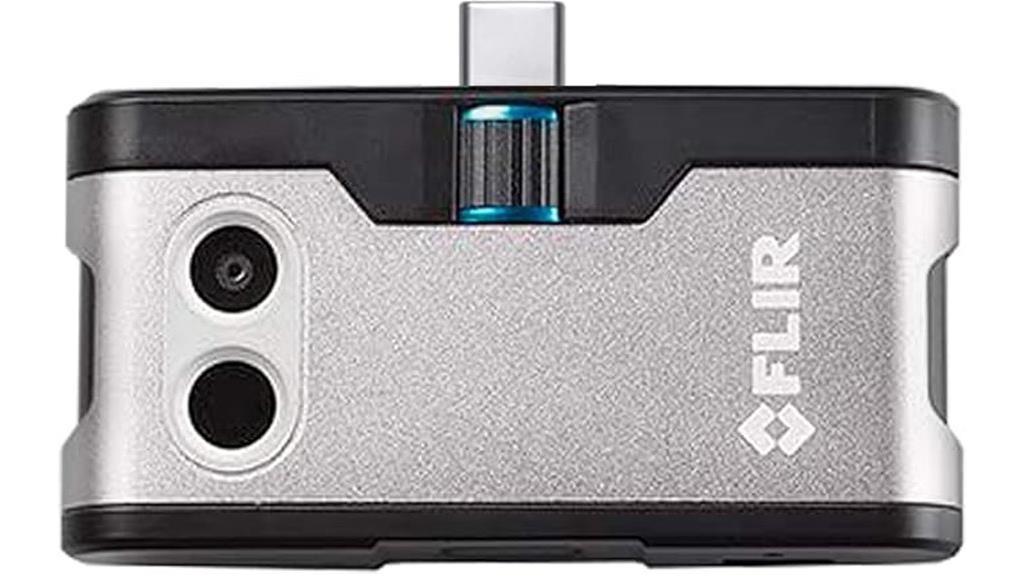
If you’re an iOS user seeking an affordable yet effective thermal imaging solution, the FLIR ONE Gen 3 stands out by transforming your smartphone into a capable thermal camera. Compatible with iPhones with USB-C ports (iPhone 15 and newer), it easily plugs into your phone’s charging port, even with a case. It offers high-resolution infrared imaging (1440×1080 pixels) and MSX technology for clearer images. Durable enough to withstand drops, it’s perfect for home inspections, HVAC, or automotive work. While it’s best for close-range, light-duty tasks, it provides reliable thermal data with an intuitive app, making thermal imaging accessible and practical for everyday use.
Best For: homeowners, technicians, and DIY enthusiasts seeking an affordable, portable thermal imaging solution for close-range inspections and troubleshooting.
Pros:
- High-resolution thermal (80×60 pixels) and visual (1440×1080) imaging with MSX enhancement for clearer images.
- Easy to use with intuitive app integration and compatibility with iPhones featuring USB-C ports.
- Durable construction with drop resistance and included protective case, suitable for jobsite environments.
Cons:
- Limited thermal resolution compared to higher-end models, which may affect detailed inspections.
- Primarily designed for close-range use; less effective for penetrating thick materials or extreme temperatures.
- Potential strain on phone’s USB-C port during prolonged or outdoor use; may require caution or dedicated standalone units for frequent applications.
TOPDON TC004 Thermal Imaging Camera

For researchers seeking a reliable thermal imaging tool, the TOPDON TC004 stands out with its high-resolution 256×192 IR sensor and precise temperature measurement capabilities. It offers a thermal sensitivity below 40mK, an accuracy of ±1°F, and supports three measurement modes—center point, max, and min temperature. With a fast 25Hz frame rate and a temperature range from -4°F to 662°F, it handles a variety of applications. Features like auto and manual focus, LED work light, IP54 durability, and a 12-hour battery support long, versatile use. Its real-time connectivity, 3D imaging, and multiple color palettes make it a practical choice for diagnostics, inspections, and research.
Best For: researchers, professionals, and DIY enthusiasts seeking a high-precision thermal imaging device for diagnostics, inspections, and experimental applications.
Pros:
- High-resolution 256×192 IR sensor with clear, detailed imaging
- Accurate temperature measurement with ±1°F precision and multiple measurement modes
- Long-lasting 12-hour battery life with durable, ergonomic design suitable for extended use
Cons:
- Requires third-party software (WINZIP and RAR files) for updates, which may incur additional costs
- Limited compatibility with Mac and some file management issues reported by users
- Slight display lag during complex processing tasks can affect real-time analysis
F2VW Thermal Camera with IR and Visual Cameras

With its high-resolution IR sensor and advanced Super Resolution algorithm, the F2VW thermal camera delivers crisp, detailed thermal images that are ideal for research applications requiring precise temperature analysis. Its 256×192 IR resolution, boosted to 640×480, provides clear visuals on a 3.2-inch LCD screen at 25 Hz. The camera’s sensitivity below 40 mK and the VOx detector’s ability to detect temperature differences as small as 0.04℃ ensure accurate measurements. Featuring both IR and visual cameras, it offers modes like Fusion and PIP for enhanced analysis. Wi-Fi connectivity, multiple color palettes, and real-time temperature alerts make it versatile and user-friendly for detailed thermal research.
Best For: DIY homeowners, technicians, and energy auditors seeking high-resolution thermal imaging for precise diagnostics and research applications.
Pros:
- High-resolution IR sensor with Super Resolution boosting images to 640×480 for detailed thermal visuals
- Versatile modes including Fusion and PIP for comprehensive analysis and overlay of visual and thermal data
- Wireless connectivity and real-time temperature alerts enhance workflow and early detection of issues
Cons:
- Initial artifacts reported in some units, requiring customer service for replacements
- Limited temperature range (-4℉ to 1022℉), which may not suit extremely high-temperature industrial uses
- Requires firmware updates to unlock full features and improve response time
HF256 Thermal Imaging Camera with 256 x 192 IR Resolution
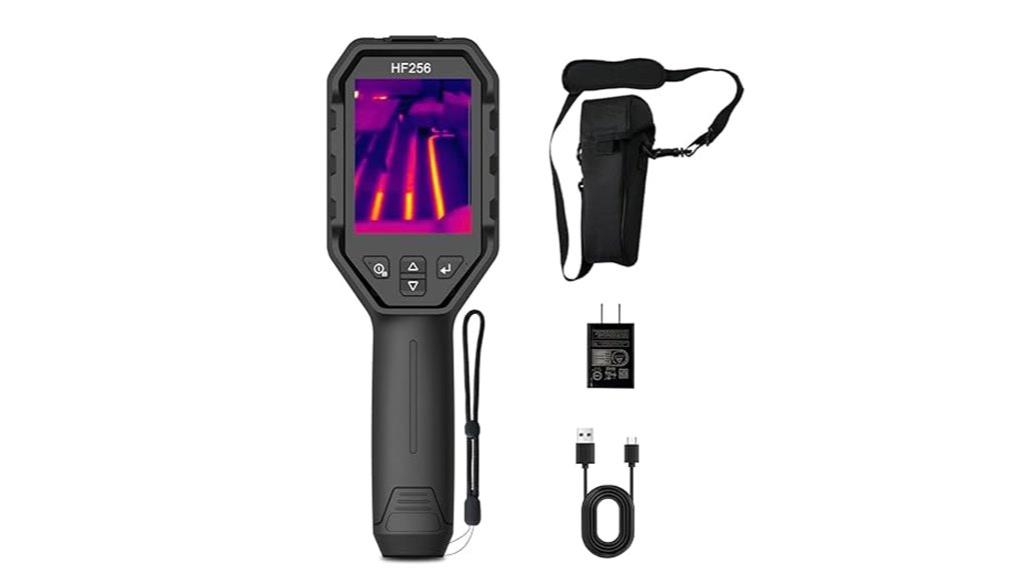
The HF256 thermal imaging camera stands out for its high-resolution 256×192 IR sensor, making it an excellent choice for researchers who need detailed thermal data. Its resolution is enhanced to 320×240 pixels using HSFTOOLS Snapshot Super Resolution, providing clearer images, while its thermal sensitivity below 40 mK detects subtle temperature differences. The device features six color palettes for versatile visualization and a compact, user-friendly design with a 3.2-inch LCD screen. Despite some calibration and accuracy limitations, it’s durable with IP54 rating and built-in tripod mount, making it suitable for various inspection tasks. Its affordability and reliable performance make it a popular tool for professional and home use.
Best For: professionals and researchers requiring detailed thermal imaging for building inspections, electrical diagnostics, and scientific analysis.
Pros:
- High thermal sensitivity below 40 mK for detecting subtle temperature differences
- Enhanced resolution of 320×240 pixels via Snapshot Super Resolution for clearer images
- Durable IP54 rating with shock resistance up to 6.6 feet, suitable for harsh environments
Cons:
- Manual calibration procedures are unclear and may lead to accuracy drift over time
- Non-removable battery raises concerns about longevity and replacement costs
- Built-in lens cover is hidden and lacks clear marking, making it difficult to open and protect the lens
Handheld Thermal Camera with 512×384 Resolution
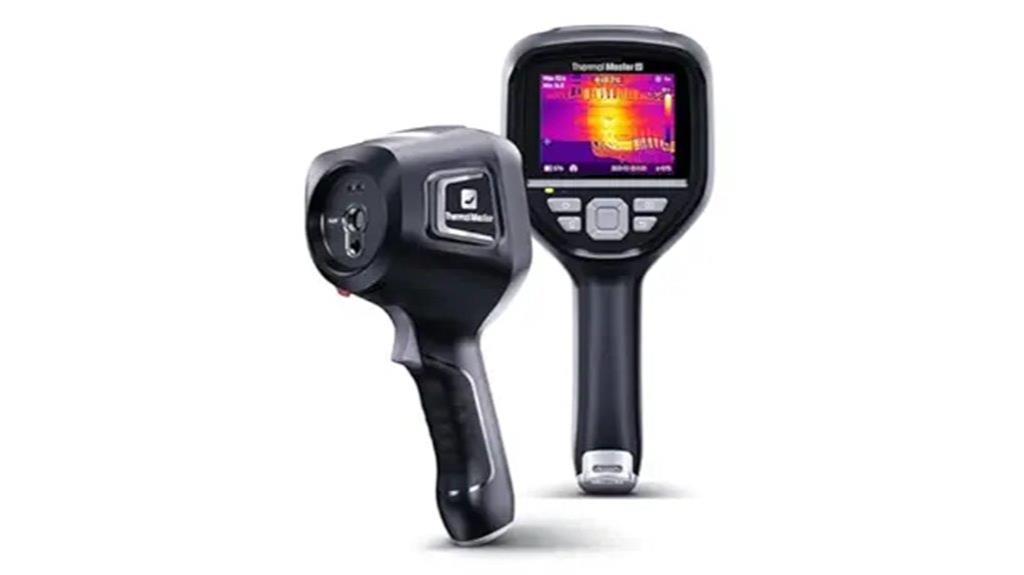
A handheld thermal camera with 512×384 resolution offers researchers unmatched detail and clarity, making it ideal for precise thermal inspections. Its advanced X³IR technology enhances thermal resolution, supporting a 60Hz refresh rate and ultra-fine 35mK sensitivity for detailed imaging. Equipped with a 2MP visible light camera and a 3.5-inch IPS display, it supports multiple viewing modes, including fusion overlay and PIP. Features like adjustable emissivity, laser pointer, and temperature alarms ensure accurate diagnostics. With wireless data transfer, microSD storage, and a rugged IP54 design, it’s perfect for demanding outdoor and industrial environments, providing reliable, high-quality thermal insights.
Best For: professionals and enthusiasts requiring high-resolution thermal imaging for detailed inspections in industrial, electrical, HVAC, or building diagnostics.
Pros:
- Ultra-fine 512×384 resolution with advanced X³IR technology for highly detailed thermal images.
- Supports multiple viewing modes, including fusion overlay and Picture-in-Picture, for versatile analysis.
- Rugged IP54 construction with long battery life and wireless connectivity for outdoor and demanding environments.
Cons:
- Lacks macro lens support out-of-the-box, limiting close-range detailed inspections.
- No weather-sealed case, which may reduce durability in harsher conditions without additional protection.
- No button hold feature for scrolling through menus, potentially affecting ease of navigation during prolonged use.
FLIR TG165-X Thermal Imaging Camera
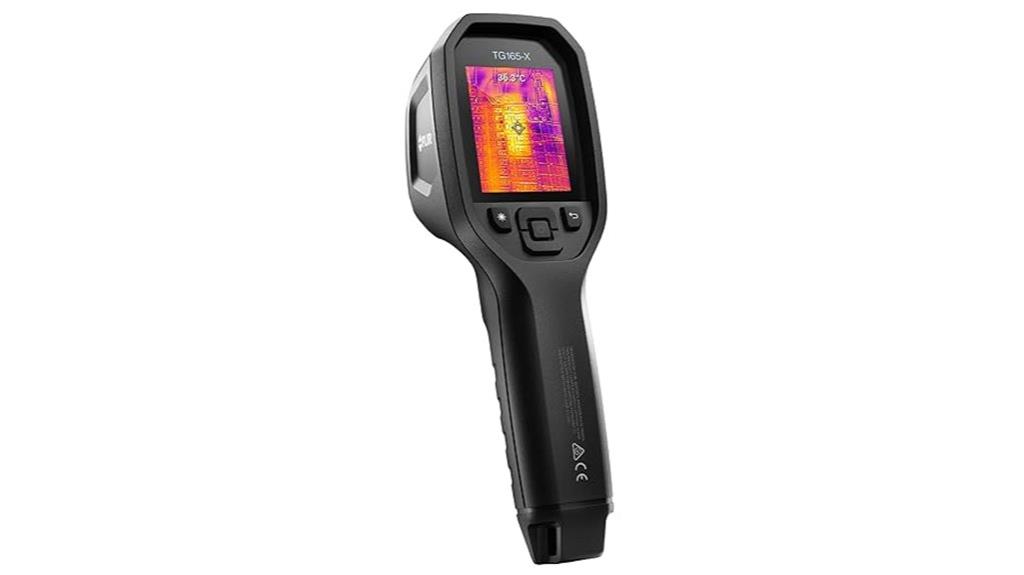
If you’re seeking a reliable thermal imaging camera for building inspections, HVAC diagnostics, or electrical troubleshooting, the FLIR TG165-X stands out with its 4,800-pixel IR sensor capable of measuring temperatures from -25°C to 300°C. It uses patented MSX image enhancement, embossing visual details onto thermal images for sharper clarity. The device features a laser pointer for precise targeting, internal storage for up to 50,000 images, and a rechargeable battery for extended use. Rugged and drop-tested, it’s protected by an IP54 enclosure, making it suitable for various environments. Its user-friendly design and intuitive controls make it an excellent choice for both professionals and enthusiasts.
Best For: DIY enthusiasts, building inspectors, HVAC technicians, and electrical professionals seeking an easy-to-use, durable thermal imaging camera for diagnosing temperature-related issues.
Pros:
- Sharp image quality with patented MSX image enhancement for clearer visuals
- Rugged, drop-tested design with IP54 protection suitable for various environments
- Large internal storage capacity of up to 50,000 images and rechargeable battery for extended use
Cons:
- Lacks maximum and minimum temperature readings found in some lower-cost models
- Potential for overheating if left in the pouch during charging or prolonged use
- Reports of battery drain, system freezes, and bootloop issues after long-term use, with mixed warranty support
TOPDON TC002C Thermal Camera for iPhone 15/16 and iPads
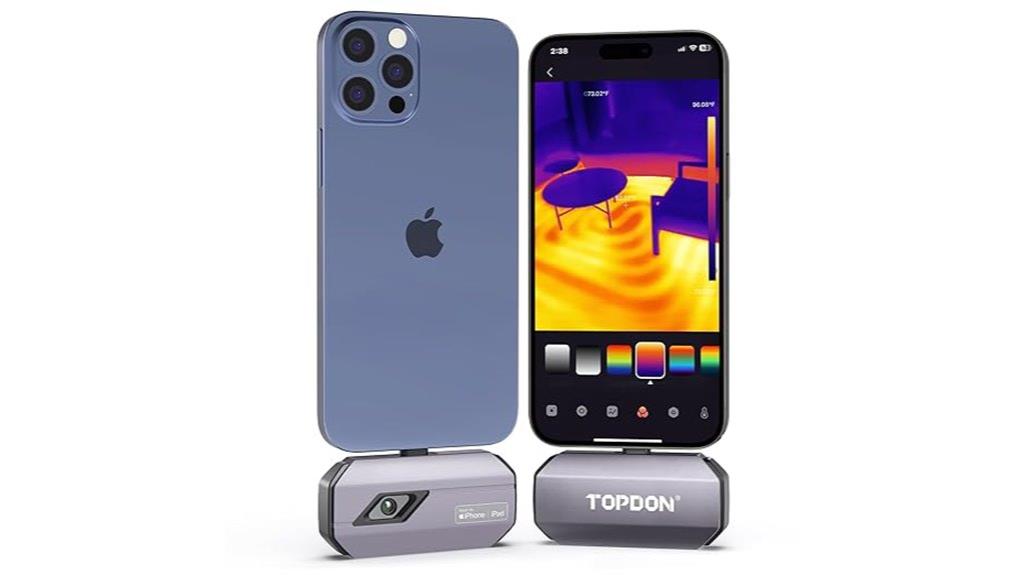
For researchers and professionals who need precise thermal imaging on the go, the TOPDON TC002C offers a compact and easy-to-use solution tailored specifically for iPhone 15/16 and iPads. It features a USB-C port compatible with recent Apple devices, providing high-resolution images with a 512×384 sensor and a 25Hz refresh rate for smooth readings. Its rotatable design, photo/video recording, and real-time temperature visualization make troubleshooting electrical, insulation, or heat leak issues straightforward. Lightweight at just 30 grams, it’s perfect for fieldwork, offering up to 10 hours of use. The device’s seamless app integration enhances control, making it a practical choice for professionals needing reliable thermal imaging on the move.
Best For: professionals and DIY enthusiasts who need portable, high-resolution thermal imaging specifically compatible with iPhone 15/16 and iPads for troubleshooting electrical, insulation, or heat leak issues.
Pros:
- Compact, lightweight design (30g) ideal for field use and on-the-go inspections.
- High-resolution imaging with 512×384 sensor and 25Hz refresh rate ensures clear, smooth thermal readings.
- Seamless app integration with control features like photo/video recording and real-time temperature visualization.
Cons:
- Limited compatibility, not suitable for Mac or Android devices.
- Occasional app freezes, calibration drift, and interface issues reported by some users.
- Slight concerns about app security and the need to learn software functions for optimal use.
Factors to Consider When Choosing Thermal Imaging Cameras for Research
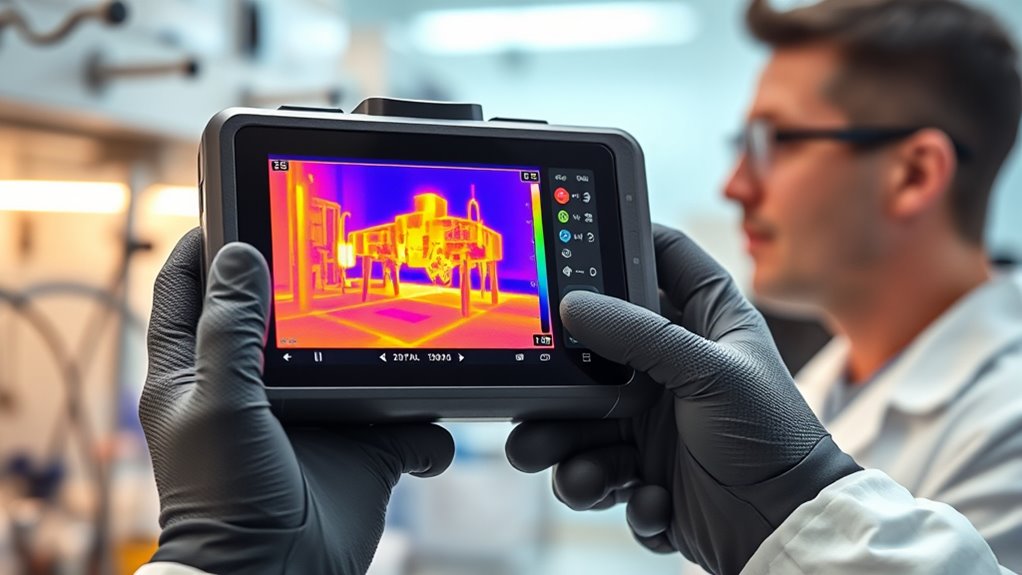
When selecting a thermal imaging camera for research, I focus on key factors like resolution and sensitivity to guarantee detailed images, and measurement accuracy for reliable data. Durability and build quality matter too, especially in demanding environments, along with connectivity options and software compatibility for seamless integration. Finally, I weigh the cost against the value offered to find a camera that meets my needs without overspending.
Resolution and Sensitivity
Choosing the right thermal imaging camera for research hinges on understanding its resolution and sensitivity. Higher resolution sensors, like 320×240 or above, deliver more detailed images, which are crucial for detecting small or subtle temperature differences. Sensitivity below 40mK allows for the detection of minute thermal variations, essential for precise analysis. While software algorithms such as super resolution can improve image clarity, they may not match the detail of native high-resolution sensors. Accurate temperature measurement within ±2% or ±3.6°F ensures reliable data, especially when identifying small thermal anomalies. However, cameras with lower sensitivity, like 50mK or higher, can miss subtle gradients, reducing overall research quality. Balancing resolution and sensitivity is key to obtaining accurate, detailed thermal data for research purposes.
Measurement Accuracy
Selecting a thermal imaging camera with high measurement accuracy is crucial for producing reliable research data. Most quality cameras offer accuracy within ±2% or roughly ±3.6°F, which is critical for precise measurements. Cameras with sensitivity below 50mK can detect subtle temperature differences, aiding detailed analysis. Proper calibration—adjusting for emissivity, distance, and environmental factors—is essential to ensure readings reflect real conditions. Consistency is equally important; many professional models include built-in calibration routines to maintain accuracy over time. External influences such as ambient temperature, reflective surfaces, and measurement distance can impact results, so managing these variables is necessary. Ultimately, choosing a camera with proven accuracy and reliable calibration features ensures your research data remains precise and trustworthy.
Durability and Build
Durability and build quality are essential factors to contemplate because research environments often involve challenging conditions. I recommend choosing a thermal camera with an IP54 or higher rating to guarantee dust and water resistance, protecting it from harsh elements. Look for models with rugged, drop-resistant casings tested for drops from at least 2 meters, which can withstand accidental impacts during fieldwork. Materials like reinforced plastic or metal not only increase durability but also extend the camera’s lifespan in demanding settings. Proper seals and gaskets are crucial to prevent dust ingress and water damage. Additionally, an ergonomic, slip-resistant grip and balanced weight improve handling and reduce fatigue during long inspection sessions. Prioritizing these features guarantees your equipment remains reliable in tough research environments.
Connectivity and Software
When evaluating thermal imaging cameras for research, connectivity and software capabilities are crucial for efficient data management and analysis. Compatibility with devices like smartphones, tablets, or PCs makes transferring, analyzing, and sharing data straightforward. The quality of dedicated software or apps directly impacts measurement accuracy, scene recognition, and post-inspection reporting. Wireless features such as Wi-Fi or Bluetooth enable real-time image streaming and remote control, streamlining workflows. Support for cloud storage or integration with third-party platforms helps organize data and facilitates long-term management. Additionally, software updates and firmware support are essential for maintaining functionality, adding new features, and ensuring compatibility with evolving operating systems. Together, these factors enhance usability, accuracy, and productivity in research settings.
Cost and Value
Choosing the right thermal imaging camera involves balancing cost with the features that deliver the best research value. Prices range from around $150 for basic models to over $1,000 for professional-grade devices, impacting overall worth based on needed features. Higher-cost cameras typically offer better resolution, sensitivity, and software capabilities, ensuring more accurate and reliable data. Budget options might lack advanced features like super resolution, precise calibration, or extensive data storage, which can limit their suitability for detailed research. Investing in a more advanced camera can save money long-term by reducing errors, speeding up inspections, and improving data quality. By evaluating the cost-to-performance ratio, I can choose a thermal camera that provides superior value tailored to my research needs and budget constraints.
Frequently Asked Questions
How Do Thermal Imaging Cameras Differ in Accuracy for Scientific Research?
Thermal imaging cameras differ in accuracy based on their sensor quality, calibration, and resolution. I’ve found that higher-end models with advanced detectors provide more precise temperature readings, essential for scientific research. Factors like thermal sensitivity and image processing also play a role. When choosing a camera, I look for those with rigorous calibration standards and high resolution to make certain my measurements are reliable and consistent across experiments.
What Is the Typical Lifespan of High-End Thermal Cameras in Research Settings?
High-end thermal cameras typically last around 5 to 10 years in research settings, but their lifespan depends on usage and maintenance. I always guarantee proper calibration and regular servicing to extend their durability. With careful handling, I’ve seen these cameras perform reliably for many years, providing precise thermal data vital for my research. Proper storage and avoiding harsh environments also help maximize their longevity.
How Important Is Temperature Range When Selecting a Thermal Camera for Experiments?
Temperature range is pretty essential when choosing a thermal camera for experiments. It’s like finding the right lens for a camera—if it doesn’t cover the necessary spectrum, you might miss critical details. I always look for a camera with a broad enough range to handle the extremes of my work, ensuring accurate readings across all conditions. It’s about precision and peace of mind, especially in sensitive research environments.
Can Thermal Cameras Be Integrated With Other Research Equipment or Software?
Yes, thermal cameras can be integrated with other research equipment and software. I often connect them to data analysis tools or control systems to streamline my workflow. Many models offer SDKs or APIs, making it easier to customize and automate processes. This integration helps me gather more precise data and enhances my research capabilities, ensuring I can analyze thermal patterns alongside other experimental parameters seamlessly.
What Are the Maintenance and Calibration Requirements for Precision Thermal Imaging Devices?
Maintaining precision thermal imaging devices requires regular calibration and proper care. I recommend calibrating your camera at least quarterly using certified calibration sources to guarantee accuracy. Keep the lens clean and free from dust or smudges, and store the device in a controlled environment to prevent damage. Regular maintenance checks help sustain ideal performance, so I always schedule these to keep my thermal imaging equipment reliable and precise for research purposes.
Conclusion
Choosing the right thermal imaging camera is like finding the perfect lens for your research microscope—each one offers unique clarity and depth. With options ranging from compact to high-resolution models, you can tailor your choice to your needs. Remember, the right tool can turn complex data into a clear picture, much like shining a light in the dark. Invest wisely, and watch your research illuminate new horizons.
